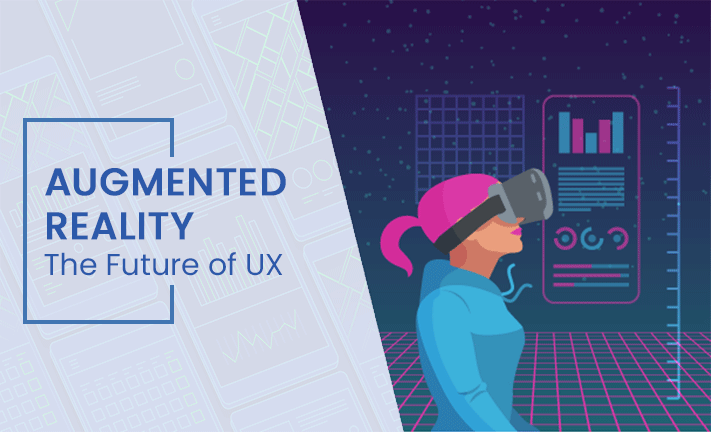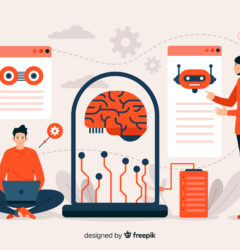06 Feb

|
Getting your Trinity Audio player ready...
|
In recent years, the digital designs of applications have broken the new horizon with the introduction of some new technology like Virtual Reality (VR) and Augmented Reality (AR) for general customers. For a while, we have been hearing that AR is the future of businesses. Augmented reality companies helped brands to learn and experiment with AR on their social media, apps, and websites. The growth of AR has been exploding.
The most notable example of this kind of application is Pokémon Go, the AR mobile game which has managed to attain around 250 million concurrent players at its peak. Working adults, small kids, and older folks also are seen to run about when they try capturing animated creatures that are overlapped with a real-life environment input captured via their phone cameras. The technology used here is AR, whereby the designers use creative UI designs to create an immersive experience that integrates the real world of the user with digital elements.
Here we will be looking at how AR is changing the user experience. With technology capable of offering personalized experiences, the focus on UX design has become more crucial. UI Design services companies help you build quite an engaging product quickly and easily.
Table of Contents
AR beyond recreation
Augmented Reality extends much beyond entertainment, having creative, practical applications like GPS overlays, measuring items, and testing beauty products. You can check out L’Oréal’s Modiface, the AR app allowing users to try on make-up products digitally, revolutionizing how fashion retails can work well in the future. Also, the architecture field has explored the use of AR for creating 3-D models of buildings to create more effective space visualization and planning. With the further progress of hardware and technology, AR and Augmented Reality companies can evolve to be a stable daily life in the future.
The biggest opportunity brought by AR
By offering real-time information regarding what the user is looking for, AR enables you to serve exactly what a user is trying to accomplish in a much more streamlined and faster way. AR provides the opportunity to provide users with the best possible experiences with the products by-
- Minimizing attention switches
- Reducing cognitive loads
- Decreasing interaction costs
AR in retail
What can retail do to improve and innovate shopping experiences? UI design Services companies are at the rescue. AR offers customers the ability to try before purchasing, which will result in a reduction in churn, a major pain point for retailers. Around 72% of AR users state that they made some unplanned purchases because of AR influence. There are many retailers who have implemented this technology successfully already. In the curve, Alibaba is ahead of the curve due to its VR shopping that allows shoppers to browse and purchase all over the world.
The new app of IKEA, IKEA Place, is one Augmented Reality App that lets people experiment, experience, and share how a good design can transform any space like a studio, school, office, or home. Their app can match furniture according to your space with 99% accuracy to ensure that it will fit perfectly in your place. Instead of taking pictures of your furniture, browsing brick-and-mortar stores, and imagining how the pieces will look in your home. You can now look through Ikea’s inventory and place the furniture you like via AR. Ikea, with this app, has solved a vital problem for customers.
The Project Color app of Home Depot utilizes AR to enable customers to overcome quite a frustrating pain point while painting a space. Project Color holds the integrity of the dimension of the room and acknowledges lighting and shadow conditions in the place, such that you can get most of the real-life visual of how the paint will look.
AR for utility
Apart from retail, there are numerous use cases for implementing Augmented Reality to enhance UX. AirMeasure is one measuring app which is not only just a tape measure but a total set of tools that will let you measure everything. Think of the time that you can save with this!
Tools
Lens Studio helps you create a magical AR experience of your own and then share them on most AR platforms worldwide- Snapchat. With the use of Maya, you will be able to create 3D animations and models and then add these to Lens Studio for exporting to Snapchat.
ARKit builds unparalleled AR experiences for millions of users on iOS, one of the biggest Augmented Reality platforms.
Biggest challenges AR brings
Same as with every huge shift in technology, there are various ways to overdo it. We have to walk a fine line between offering users the information they require and introducing more visual noise. AR will be introducing one brand-new testing challenge for an organization. While designing for one screen, there are pretty standard variables we require to design for such that our products can be accessed by a broad range of users. With the use of AR outside the screen, we have to take into consideration how our designs can interact with a great number of environments. Until wearables become more stylish and comfortable, we need to consider how the users interact physically with AR experiences.
Wrapping up
AR is the foremost truly new User Interface since when Apple rolled out its original iPhone. Moving from a keyboard and mouse to one single touch screen- it is tough to believe that it was scant a decade ago.
Nevertheless, AR is an even more radical departure from the traditional UI. With Augmented Reality, we are moving forward from physical interaction to virtual one. If we can overcome this hurdle of adoption inherent in the new technologies, AR will quite easily become something we interact with every day. Being an Augmented Reality Company to ensure that AR experiences are safe, accessible, and useful for our users.


